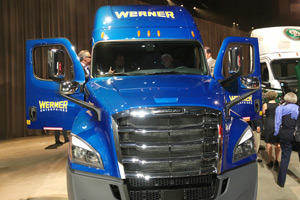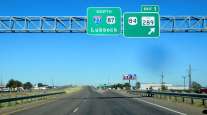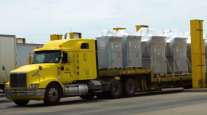Update: Freightliner Says New Cascadia Offers Fuel Gains, Connectivity Advancements

“With the new Cascadia, we have not just updated past successes. Every aspect of the truck has been reimagined. We are raising fuel efficiency, connectivity, safety, quality and uptime performance to even greater levels and also introducing a premium driver experience as a powerful customer benefit and driver retention tool,” said Richard Howard, senior vice president of sales and marketing for Daimler Trucks North America, parent of Freightliner.
"We want the new Cascadia to be 'the truck of choice for big fleets in North America,' " DTNA President Martin Daum said.
He said the model year 2018 truck will begin to hit the road in April.
Executives said the efficiency gains come from a series of enhancements, including a sloped hood and bumper with integrated air deflector to minimize drag. The new AeroX package offers additional benefits such as longer side extenders, lower chassis fairings, drive wheel covers and proprietary-designed wheel fairings.
Also introduced during a Sept. 1 press conference was Detroit Connect Analytics, available through the new connectivity platform on the Cascadia. It will provide fleets with information to identify behaviors, trends and insights on fuel consumption and safety performance data. Fleet managers can view the data for a single trip, single vehicle or their entire fleet over different periods of time.
Daum said connectivity will continue to “change the life of trucking.”
To have a “meaningful impact on the performance of either drivers or the vehicle, you need to be able to see everything and be able to consume that in a way in which you or I can understand it. Detroit Connect Analytics is our move in that direction,” said Matt Pfaffenbach, DTNA’s director of connectivity.
 Neil Abt/Transport Topics
Neil Abt/Transport Topics Also offered with the new Cascadia is the Detroit Assurance 4.0 system with active brake assist that provides full braking on stationary objects, adaptive cruise control and lane departure warning. There is also a warning should a pedestrian be picked up by the system’s radar.
In addition, Detroit’s over-the-air update capabilities, allowing customers the ability to perform remote engine parameter and other updates, will be available during the second half of 2017, the company said.
The Cascadia’s interior has received a major overhaul, starting with a centrally located hub where nearly all electronic control units are stored for easy access with no tools needed.
A new steering wheel includes one-touch buttons for key functions and is complimented by an overhauled dashboard and instrument cluster aimed at providing drivers easier-to-understand information to reduce distractions. When not on the road, an updated driver’s loft area in sleeper models has first-time features such as dimming lights.
 DTNA
DTNA Though the new Cascadia was officially unveiled Sept. 1, it was previewed one night earlier with 12 fleet customers that have spent a combined $9 billion with Freightliner in the past six years. Officials with a number of these large fleets were present at the event and credited Freightliner for acting on their suggested improvements.
The new Cascadia is available with the integrated Detroit powertrain, which combines the 400 horsepower and 1,750 pound-feet of torque of Detroit DD15 or Detroit DD13 engine with the Detroit DT12 automated manual transmission and Detroit steer and rear tandem axles.
“By combining advanced aerodynamics of the new Cascadia with the power of the high-performance, high-efficiency integrated Detroit Powertrain, we will help customers get the most out of every gallon,” Howard said. “We have provided an optimized, one-stop fuel efficiency solution.”
Daum said the current Cascadia will be produced for at least another two years. The new truck will be built in both Mexico and Cleveland, North Carolina.
Several of the @freightliner Cascadia models for customers on display @SwiftTransport @TruckingJob @TransportTopics pic.twitter.com/slEePBtnTV — Neil Abt (@NeilAbt) September 1, 2016




